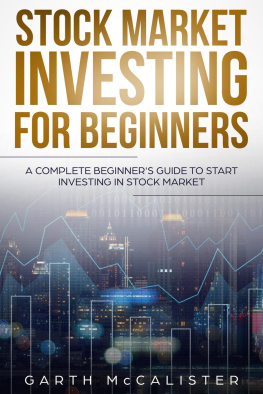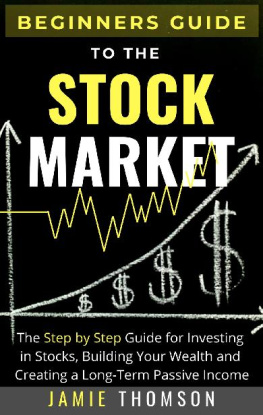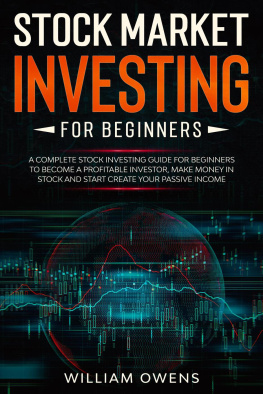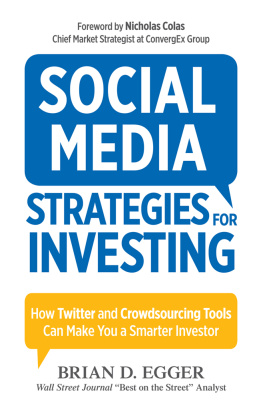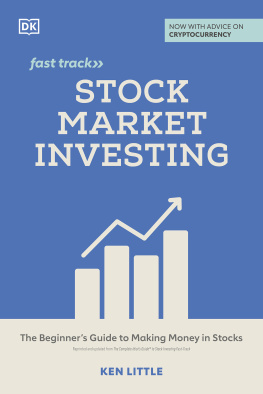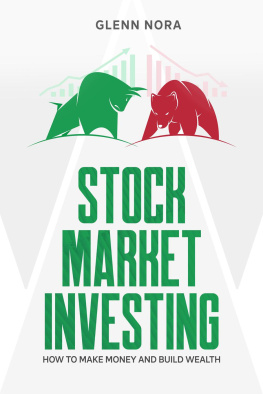The Wallstrip Edge reflects the views of its author, Howard Lindzon, and is not endorsed by CBS Corporation, CBS Interactive, or Wallstrip, which is owned by CBS.
This publication is designed to provide competent and reliable information regarding the subject matter covered. However, it is sold with the understanding that the author and publisher are not engaged in rendering legal, financial, or other professional advice. Laws and practices often vary from state to state and if legal or other expert assistance is required, the services of a professional should be sought. The author and publisher specifically disclaim any liability that is incurred from the use or application of the contents of this book.
Charts courtesy of bigcharts.com and Eric Crittenden of Blackstar Funds.
Copyright 2009 by Howard Lindzon
All rights reserved. Except as permitted under the U.S. Copyright Act of 1976, no part of this publication may be reproduced, distributed, or transmitted in any form or by any means, or stored in a database or retrieval system, without the prior written permission of the publisher.
Business Plus
Hachette Book Group
237 Park Avenue
New York, NY 10017
Visit our Web site at www.HachetteBookGroup.com.
Business Plus is an imprint of Grand Central Publishing.
The Business Plus name and logo are trademarks of Hachette Book Group, Inc.
First eBook Edition: February 2009
ISBN: 978-0-446-54443-6
To the Optimists Go the Spoils
W e live in a media-filled world of Doom and Gloomers. Too bad for them. They miss all the opportunities and, despite what anyone tells you, making money in the stock market is possible, can be fun, mostly honestand youre goddamn right.
The world has shrunk and true global markets are at your fingertips. Markets can all move together for periods of time, but for the most part you should look at the investing world as a market of STOCKS. This market of stocks is full of Beauties as well as Beasts. We are surrounded by trends; we live in a free country and do not understand the basic mechanics of the stock market. Here is a quick lesson: It is all about supply and demand and mood.
We live in a capitalist society but we dont teach investing in grade school. We should. Kids would invest better than us. They have less greed, fear, and anxiety. Most important, they are optimistic.
The years 2003 through 2007 were sweet ones for trend followers in the stock market. The emergence of China, India, Russia, Mexico, and Brazil; ETFs, low interest rates, and a weak U.S. dollar all created a perfect storm for equities around the globe. That was changing fast in late 2007, early 2008.
Winners were everywhere. Homebuilders, Internet stocks, oil, gold, emerging markets, iPods, iMacs, BlackBerries, rubber shoes, condoms, exotic dancers, guns, ammunition, aerospace, agriculture, solar power, water... the list goes on and on. By the time you read this book, many if not all of these trends will be long gone or on the way out. No matter, new trends will emerge. They always do. What you need is a simple way to track the new leaders so that when they emerge, you are ready to ride them. You will find those tools and directions in this book.
If you are reading this book, you will probably be interrupted 500 times by phone calls, e-mails, pings, pokes, text messages, kids, sleep, your blog, reading other blogs, your dog, and Twitter. If you are so engrossed as to read this wonderful book in one sitting, you will have all the above waiting for you once you are done. (And by the way, your family will be pissed.) We live in a world with distractions. On the optimistic side, those who manage them best will be rewarded with wealth.
When you watch an NFL football game today, notice how the offense and defense are built around distraction and misdirection. Its a game within the game. The stock market is no different. Technology has allowed noise into our lives for good and bad, but the basics of investing have not changed. Bankers, brokers, analysts, talking heads, tipsters, and the rest of old and new media are in the business of making noise. The key is to control that information in 2008 and beyond.
For all the noise and distraction, the idea is to have your investment dollars appreciate as much as possible. Consider Warren Buffett. He has not changed his style in fifty years. He has used technology to build risk management vehicles, but basically he buys low in hopes of selling higher (at least he thinks so). In the stock market, you buy great companies and you are generally rewarded over time; you buy them at the right time and price and you do even better. You learn how to sell them properly and you have mastered the trade. If you learn to cut your losers fast, before they become big losers, you may not get wealthy but you wont lose your fortune. Pretty easy...
I wish!
The stock market is difficult; investing is not easy. Investing with discipline may be one of the hardest things we can do well. But it is not nearly as hard as the experts would lead you to believe. This book is not a get-rich-quick diatribe. There is no green light/red light system for buying and selling your way to stock market riches. Those books have been written. If you are not open to the idea that you can make money without the advice you get from your TV, then this book is not for you. If you are going to follow trends, TV is the worst investment of your time.
I do believe that if you are going to invest you should do so with the goal of not just matching the universally accepted averages that mutual funds compete against (the Dow, Standard and Poors, Wilshire 5000), but with the intention of trouncing them.
We all want to own the next Starbucks. (In fact, a book with that title has been written. Catchy.) Trust me, I will help you do that. I will also teach you that you dont need the next Starbucks. Damn, as I write this book, Starbucks sits more than 65 percent below its all-time high of $40 in January 2008. (Maybe Starbucks is the next Starbucks.) You can find hundreds of great wealth-building companies short of the next Starbucks that will create great wealth for you. If I helped you do just that, this would be a short book. Therefore, I will help you find the next Starbucksmany of themride them, and, most important, teach you how to get off.
The media and textbooks are busy preaching how you should buy low, sell high. It makes perfect sense. Most businesses are based around that principle; otherwise they would not make profits and be able to pay bills. Here is what I always say in return: Great stocks hit all-time highs. They hit them over and over. This book is not a holy grail. Money management is the holy grail. Money management is very personal, and I will spend a lot of this bookand Chapter 5 specificallyon the subject.
Your next question may be: What makes me qualified to write a book on trends? If I am so smart, why should I take the time to share my thoughts and write a book? Great questions, and ones you should ask of every book and financial author. First off, I love to write. Its a curse/blessing. It helps me think about ideas, flesh them out, get feedback, and look at them in a new light.
This book is for those who want to be more actively involved in their financial future and learn about the pitfalls that I have faced in over ten years of actively managing a hedge fund and investing in all aspects of the stock market and private markets. It is not just about winners. I have made mistakes on the path to my success today as a husband, father, partner, investor, and friend, and Ill talk about them.
When you finish the book, I believe you will have all the basic tools to invest in long-term winners in the stock market. Throughout the book I will emphasize the following:


